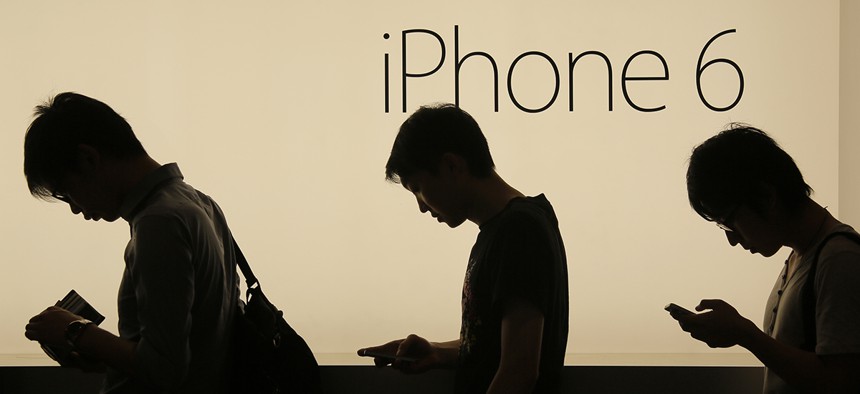Your Smartphone Performs Better in One Hand Than the Other

Vincent Yu/AP File Photo
Is right, right?
If you’ve got an iPhone, you’re likely to get better reception if you hold it in your right hand (and right ear) during a call. That’s the conclusion of a report, commissioned by the Nordic Council of Ministers, that analyzed how effectively different smartphones caught and sent radio signals.
To many of us, our black slabs are nothing but magical devices. They catch and send invisible signals, let us browse the internet and keep in touch with our friends and family. The radio signals that enable these devices to work wirelessly are caught and sent by antennas which, in the modern incarnation of smartphones, have been hidden inside the body.
However, hiding them inside comes with a usability cost. The users of these smartphones have no idea where the antenna is and thus they cannot knowingly keep it clear of obstructions. Phone companies won’t always reveal where they are and taking one apart doesn’t help, because each manufacturer puts the antenna in a different place. The result is that holding your phone in a certain hand can have a large impact on how effectively your phone’s antenna works.
To find out the effectiveness with which each phone worked, Gert Frølund Pedersen of Aalborg University placed the phones inside a sophisticated testing space that could measure signal strengths.
Your phone works by sending and receiving signals from a cell phone base station. The best way to measure the quality of voice calls is to measure how effectively the phone is able to send the signal from the phone to cell tower, because this transmission signal is the weakest link during a phone call.
Shown below are Pedersen’s results for the most popular smartphones held in the right hand at 900 MHz (the most common GSM frequency band for making calls across most of the world). The stronger the signal (measured in dBm, decibel-milliwatt), the better the phone is able to transmit during a call and thus the better the overall call quality.
For phone calls, iPhones are generally bad at transmitting signals, no matter which hand you use (and past models don’t have a great relationships with antennas either). But they are worse when held in the left hand and put to the left ear. This could be because the left-left combination adds a greater obstruction between the phone’s antenna and the wireless signal than a right-right combination would, or it could be that iPhone antennas are worse than other phones.
The tests for data services were conducted by measuring the least amount of signal strength needed to browse data (so lower the number, the more effective the phone) transmitted from the cell tower to the phone. In this case, it didn’t matter which hand you held your phone in, because you don’t have the additional obstruction of your head. And, even then, most iPhone models performed poorly compared to the competition. (See full report here for details on other phones.)
“For many phones, the voice communication performance depends strongly on which side of the head the phone is used,” the report concluded. “For the measurements on data services … the variation in performance is still significant, but not as large as for the voice measurements.”
If you mainly use your phone calls where signal strength is high, it won’t matter which hand you hold your phone in during a call. However, as I found out in my recent trip to India, signal strength can sometimes be a huge problem. In those cases, if you find your call quality isn’t great, try changing the hand in which you are holding the phone or, better still, get a hands-free set.


